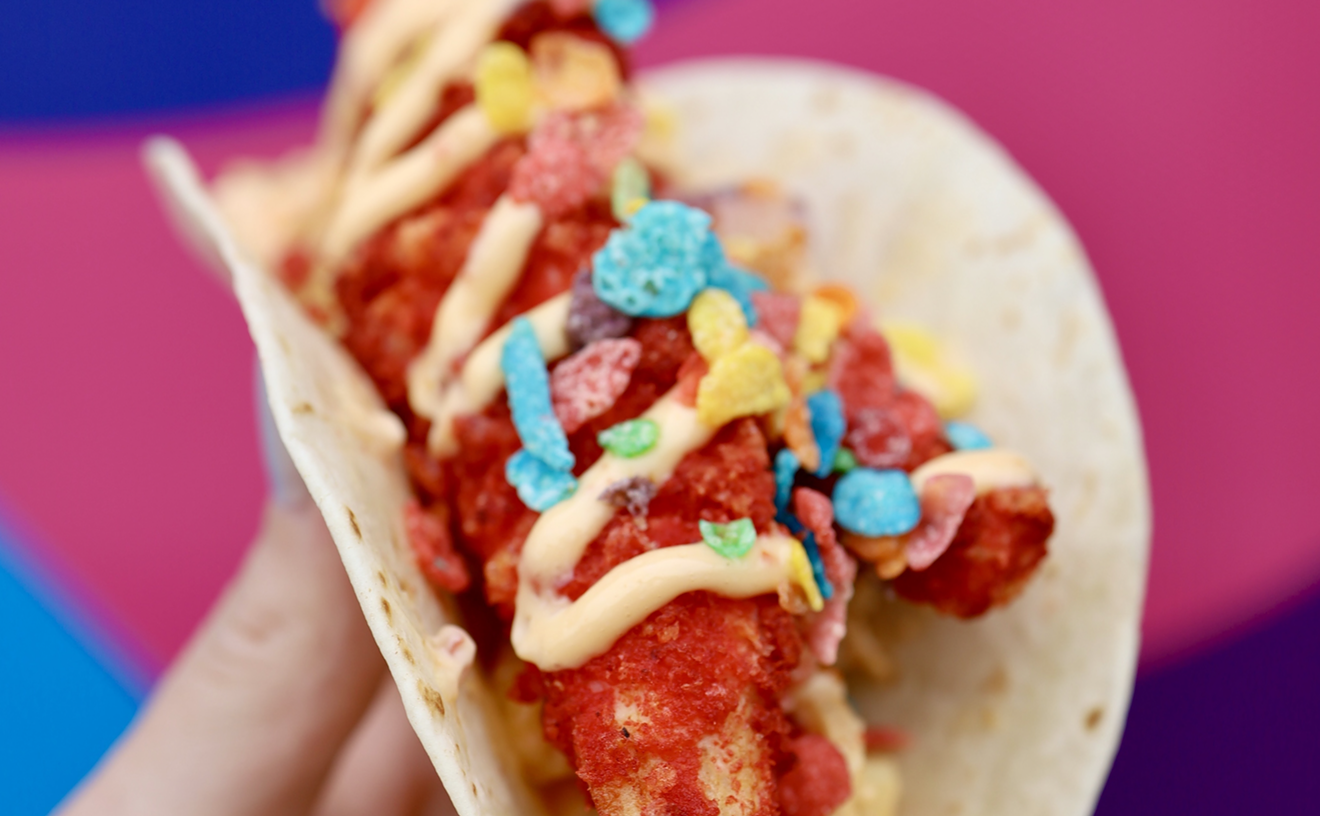What's next in bar-food trends? Let's hope more places like Flûte champagne lounge. The small but drop-dead gorgeous space, featuring a maze of velvet-upholstered private alcoves seating anywhere from two (hot date) to eight (after-work paaarty!) served by a friendly staff, puts most of South Beach's überlounges to shame. And the light, elegant eats match the décor -- as does, needless to say, the signature drink.
Unlike still wines, champagne and other sparkling wines (properly, only sparkling wine from France's Champagne region can claim the name) go with virtually all types of cuisine. Since the start of the New Millennium, trendmeisters have even paired urbane bubbly with some of the most hard-core brewski foods, like barbecue and Chinese take-out. Still such an exquisitely elegant quaff most often seems ideally suited to evenings when one wants to graze on equally suave light bites -- "just enough to satisfy without overwhelming the palate," according to Flûte's French owner, Hervé Rousseau, who pioneered the chomping à la champers concept with two wildly successful Flûtes in Manhattan before opening here last Valentine's Day. Among Flûte's sophisticated but solidly satisfying noshes are three salads (including a sun-dried tomato/mesclun model with warm goat cheese whose smoothness is great fun combined with champagne's fizz), an unusual tuna tartare dressed non-Asian, and a first-rate foie gras terrine, with a buttery richness and sauterne-tinged pear chutney.
Flûte's most creative cuisine de bar bites are five "fusion spring rolls," not deep-fried but the refreshing raw rice paper-wrapped kind that Vietnamese sometimes call summer rolls. A vegetarian friend enjoyed the primavera, whose ingredients were all-Asian (bean sprouts, Oriental greens, cucumber, hoisin, avocado, and hoisin dipping sauce) except for the protein: fresh mozzarella. Rolls are served cut into bite-sized pieces and skewered, for easy no-mess eating.
But naturally the classic culinary soul mate of champagne is caviar. Americans consume one-third of the world's caviar; in fact New York's Hudson River was once the world's biggest producer of caviar. Until it was depleted of sturgeon by overfishing in the 1890s, it was common practice for big bowls of caviar to be put out as freebie bar snacks, like salted pretzels and peanuts are today, to increase patrons' thirst. You will not find this practice at Flûte, where caviar from Petrossian Paris runs $55 to $95 per 30 grams, which is roughly an ounce, which is roughly no more than a generously rounded tablespoon and a half. But then Flûte's caviar likely wouldn't increase drink sales, because all five varieties offered are top grade, therefore only minimally salted.
According to a 1917 FDA decision, only sturgeon roe can be legally labeled caviar without a qualifier (such as "lumpfish crapola"), and the unqualified real thing's all Flûte sells. However, along with beluga, osetra, and sevruga -- so called from the three different varieties of Caspian Sea sturgeon from which the caviar comes -- are two unusual offerings, farmed French baerii and American transmontanus. The latter pair are both especially intriguing, as Caspian sturgeon have been in bad shape since the Soviet Union's dissolution due to phenomenally increased unpoliced poaching and black marketing as well as pollution; beluga sturgeon are close to extinction. So my environmentally concerned dining partner and I taste-tested the French and U.S. contenders.
The Royal transmontanus was a revelation. Developed over the past eighteen years by Stolt Sea Farm in northern California, from a white sturgeon species closely related to the Caspian osetra sturgeon, the U.S. caviar was fully equal in quality to the best imported osetra. Mid-sized between beluga and osetra, the transmontanus had osetra's firmer-than-beluga texture and its classic pronounced rich yet clean, nutty flavor, plus some unique complexities all its own: hints of fruity and/or herbal sweetness that made the U.S. roe's brine tang seem not so much sealike as winelike.
Less uniquely complex but almost equally wonderful was the Royal French baerii, a sevruga ringer for understandable reasons: It was developed from Siberian sturgeon and farmed in conditions identical to native waters. Of the three Caspian caviars, sevruga are the smallest and have the most intense flavor, characteristics the baerii we sampled shared. The fine-grained eggs had a bright, bracing, briny yet buttery aroma and taste and, in texture, came close to duplicating what many consider sevruga's chief charm: When eaten, the small pearls produce the most pronounced "pop" of any caviar.
With your repast, Flûte offers eighteen champagnes and sparkling wines by the glass and many more by the bottle; six-ounce glasses run from $8 to $25 and bottles from $25 to $495. There's also a $19 Magic Flute tasting of three champagnes (in 2.5 ounce mini-Flûtes), and endless imaginative champagne cocktails. Our bottle of the cheapest $25 plonk, Seaview from Australia, was just fine -- no complex nose or long finish, just some refreshing citrus/floral top notes and a lot of festive bubbles.
To finish Flûte adds the third "C" to complete the perfect champagne/caviar match: chocolate. The not-too-sweet Chocolate Bomb is actually terrific, one of the few specimens of this dessert I've sampled in years that I haven't wanted to bomb out of existence. But a more suitably elegant end might be just one of the sumptuous chocolates Flûte sells by the piece, flown in from Paris's La Maison du Chocolat -- perhaps a single Salvado, dark chocolate intensified by fresh raspberry essence. It's not a lot of food. But who could ask for anything more?










